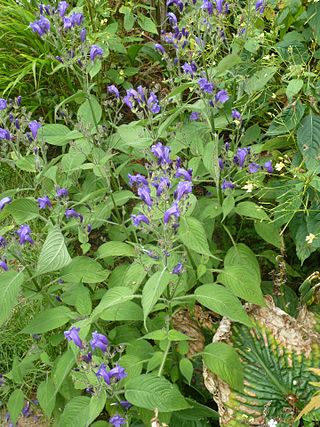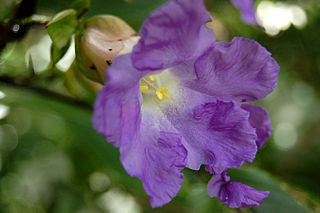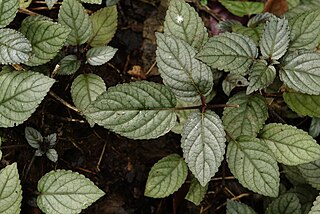
Acanthaceae is a family of dicotyledonous flowering plants containing almost 250 genera and about 2500 species. Most are tropical herbs, shrubs, or twining vines; some are epiphytes. Only a few species are distributed in temperate regions. The four main centres of distribution are Indonesia and Malaysia, Africa, Brazil, and Central America. Representatives of the family can be found in nearly every habitat, including dense or open forests, scrublands, wet fields and valleys, sea coast and marine areas, swamps, and mangrove forests.

Strobilanthes is a genus of about 350 species of flowering plants in the family Acanthaceae, mostly native to tropical Asia and Madagascar, but with a few species extending north into temperate regions of Asia. Many species are cultivated for their two-lipped, hooded flowers in shades of blue, pink, white and purple. Most are frost-tender and require protection in frost-prone areas. The genus is most famed for its many species which bloom on long cycles of several years, such as Strobilanthes wightii which blooms every thirteen years.

Bdellium is a semi-transparent oleo-gum resin extracted from Commiphora wightii plants, and from Commiphora africana trees growing in sub-saharan Africa. According to Pliny the best quality came from Bactria. Other named sources for the resin are India, Pakistan, Arabia, Media, and Babylon.
Monocarpic plants are those that flower and set seeds only once, and then die.

Strobilanthes kunthiana, known as Kurinji or Neelakurinji in Tamil language and Malayalam and Gurige in Kannada, is a shrub of the bear's breeches family (Acanthaceae) that is found in the shola forests of the Western Ghats in Kerala, Karnataka and Tamil Nadu. The purplish blue flower blossoms only once in 12 years, and gave the Nilgiri Mountains range its name as nil (blue) + giri (mountains). The name Neelakurinji originates from the Tamil Language neela (blue) + kurinji (flower). Of all long interval bloomers Strobilanthes kunthiana is the most rigorously demonstrated, with documented bloomings in 1838, 1850, 1862, 1874, 1886, 1898, 1910, 1922, 1934, 1946, 1958, 1970, 1982, 1994, 2006, 2018 and 2022, these have no match to Solar cycles.

Robert Wight was a Scottish surgeon in the East India Company, whose professional career was spent entirely in southern India, where his greatest achievements were in botany – as an economic botanist and leading taxonomist in south India. He contributed to the introduction of American cotton. As a taxonomist he described 110 new genera and 1267 new species of flowering plants. He employed Indian botanical artists to illustrate many plants collected by himself and Indian collectors he trained. Some of these illustrations were published by William Hooker in Britain, but from 1838 he published a series of illustrated works in Madras including the uncoloured, six-volume Icones Plantarum Indiae Orientalis (1838–53) and two hand-coloured, two-volume works, the Illustrations of Indian Botany (1838–50) and Spicilegium Neilgherrense (1845–51). By the time he retired from India in 1853 he had published 2464 illustrations of Indian plants. The standard author abbreviation Wight is used to indicate this person as the author when citing a botanical name.
Plietesials are plants that grow for a number of years, flower gregariously (synchronously), set seed and then die. The length of the cycle can vary between 8 and 16 years. For example, the neelakurinji plant flowers every 12 years and bloomed as expected in 2006 and 2018 in the Munnar region of Kerala, India.

Commiphora wightii, with common names Indian bdellium-tree, gugal, guggal, guggul, gugul, or mukul myrrh tree, is a flowering plant in the family Burseraceae, which produces a fragrant resin called gugal, guggul or gugul, that is used in incense and vedic medicine. The species is native to western India, from where it was introduced westward to southern Pakistan and the middle-east. It prefers arid and semi-arid climates and is tolerant of poor soil.

Strobilanthes wallichii, commonly known as Kashmir acanthus, hardy Persian shield, wild petunia, or kandali, is a herbaceous perennial which is native to the Himalayas. In its natural habitat, it purple blooms appear only once every twelve years, an occasion which is celebrated by the Kandali Festival in the Pithoragarh District in India.
Dichaetaria is a monotypic genus of South Asian plants in the grass family. Its only species is Dichaetaria wightii, native to southern India and Sri Lanka.

Strobilanthes callosa(Synonym: Carvia callosa Bremek) is a shrub found mainly in the low lying hills of the Western Ghats, all along the west coast of India. Its standardized Hindi name is maruadona (मरुआदोना) which it is called in the state of Madhya Pradesh where it is also found. In the state of Maharashtra, in the Marathi language, and other local dialects and in the neighboring state of Karnataka, the shrub is locally known as karvi (कारवी), sometimes spelled in English as karvy.

Junonia iphita, the chocolate pansy or chocolate soldier, is a butterfly found in Asia.

Strobilanthes dyeriana, the Persian shield or royal purple plant, is a species of flowering plant in the acanthus family Acanthaceae, native to Myanmar.

Strobilanthes alternata, may be known as red ivy, red-flame ivy, or waffle plant, is a member of the family Acanthaceae native to Java. It is a prostrate plant with purple colored leaves.

Acanthoideae is a subfamily of plants in the family Acanthaceae.
Strobilanthes involucrata is a species of flowering plants in the family Acanthaceae and the tribe Ruellieae. It is found in south-east Asia: native to Java and introduced to Indo-China. This was previously considered a species of the monotypic genus Pachystrobilus.
Strobilanthes penstemonoides is a species of flowering plant in the family Acanthaceae. It occurs in China, Bhutan, India, and Nepal. Its specific epithet has been spelled as penstemonoides, pentstemonoides, and pentastemonoides.

Neonotonia wightii, the perennial soybean, is a species of flowering plant in the family Fabaceae, native to sub‑Saharan Africa, Yemen, India, and Sri Lanka, and widely introduced as a forage in Brazil, Bolivia, Paraguay, northern Argentina, the Mascarene Islands, Peninsular Malaysia, Java, New Guinea, Queensland and New South Wales in Australia, and Fiji. It is shade tolerant.

Strobilanthes cusia, also known as Assam indigo or Chinese rain bell, is a perennial flowering plant of the family Acanthaceae. Native to South Asia, China, and Indochina, it was historically cultivated on a large scale in India and China as a source of indigo dye, which is also known as Assam indigo. In addition to being used for dye, it is also used in the traditional Chinese herbal medicine "Qingdai". Other names for this dicot include Pink strobilanthes and Strobilanthes flaccidifolius, where flaccidifolius is Latin for "drooping leaves".













